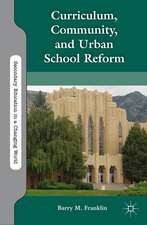The Brain at School: Educational Neuroscience in the Classroom
Autor John Geakeen Limba Engleză Paperback – 16 aug 2009
Professor Martin Westwell, Director, Flinders Centre for Science Education in the 21st Century, Flinders University, AustraliaWithin education there is a growing interest in neuroscience research and what it can teach us. This book focuses on what neuroscience means for education professionals - in key areas such as learning, memory, intelligence and motivation - and addresses questions such as:
- How does the brain enable us to learn?
- Why do some children have learning difficulties, such as ADHD or dyslexia?
- How can actual scientific research be applied to pedagogy and curriculum design
Preț: 259.71 lei
Nou
Puncte Express: 390
Preț estimativ în valută:
49.69€ • 51.89$ • 41.13£
49.69€ • 51.89$ • 41.13£
Carte tipărită la comandă
Livrare economică 04-18 aprilie
Preluare comenzi: 021 569.72.76
Specificații
ISBN-13: 9780335234219
ISBN-10: 0335234216
Pagini: 248
Dimensiuni: 152 x 229 x 13 mm
Greutate: 0.34 kg
Editura: McGraw Hill Education
Colecția Open University Press
Locul publicării:United Kingdom
ISBN-10: 0335234216
Pagini: 248
Dimensiuni: 152 x 229 x 13 mm
Greutate: 0.34 kg
Editura: McGraw Hill Education
Colecția Open University Press
Locul publicării:United Kingdom
Cuprins
INTRODUCTION
A case for educational neuroscience
Caveats and disclaimersCHAPTER 1: WHY EDUCATIONAL NEUROSCIENCE?
Education neuroscientific research questions
Limits to educational neuroscience
CHAPTER 2: NEUROIMAGING TECHNOLOGIES
CHAPTER 3: LEARNING AND MEMORY
Individual brains
Hebb's model of learning through synaptic plasticity
Memory
CHAPTER 4: WORKING MEMORY AND INTELLIGENCE
Working memory
Attention
Intelligence
Gifted and talented pupils
Sex differences
Genetics of intelligence
IQ scores as a measure of social evolution
CHAPTER 5: CREATIVITY AND IMAGINATION
Fluid analogising
Creative intelligence
Imagination
CHAPTER 6: SOCIALISING, EMOTION AND MOTIVATION
Mirror neurons and socialising
Emotion
Motivation and self-esteem
Attention Deficit Hyperactivity Disorder
CHAPTER 7: LANGUAGE AND LITERACY
Language
Story telling
Literacy
Dyslexia
Second language learning
CHAPTER 8: NUMERACY AND MATHEMATICS
Arithmetic
Statistics
Fractions
Algebra and geometry
Mathematical thinking
Mathematical creativity
CHAPTER 9: ARTS CURRICULUM
Music
Visual arts
CHAPTER 10: A FUTURE FOR EDUCATIONAL NEUROSCIENCE
Schools of the future
An agenda for educational neuroscience
Last word
A case for educational neuroscience
Caveats and disclaimersCHAPTER 1: WHY EDUCATIONAL NEUROSCIENCE?
Education neuroscientific research questions
Limits to educational neuroscience
CHAPTER 2: NEUROIMAGING TECHNOLOGIES
CHAPTER 3: LEARNING AND MEMORY
Individual brains
Hebb's model of learning through synaptic plasticity
Memory
CHAPTER 4: WORKING MEMORY AND INTELLIGENCE
Working memory
Attention
Intelligence
Gifted and talented pupils
Sex differences
Genetics of intelligence
IQ scores as a measure of social evolution
CHAPTER 5: CREATIVITY AND IMAGINATION
Fluid analogising
Creative intelligence
Imagination
CHAPTER 6: SOCIALISING, EMOTION AND MOTIVATION
Mirror neurons and socialising
Emotion
Motivation and self-esteem
Attention Deficit Hyperactivity Disorder
CHAPTER 7: LANGUAGE AND LITERACY
Language
Story telling
Literacy
Dyslexia
Second language learning
CHAPTER 8: NUMERACY AND MATHEMATICS
Arithmetic
Statistics
Fractions
Algebra and geometry
Mathematical thinking
Mathematical creativity
CHAPTER 9: ARTS CURRICULUM
Music
Visual arts
CHAPTER 10: A FUTURE FOR EDUCATIONAL NEUROSCIENCE
Schools of the future
An agenda for educational neuroscience
Last word













